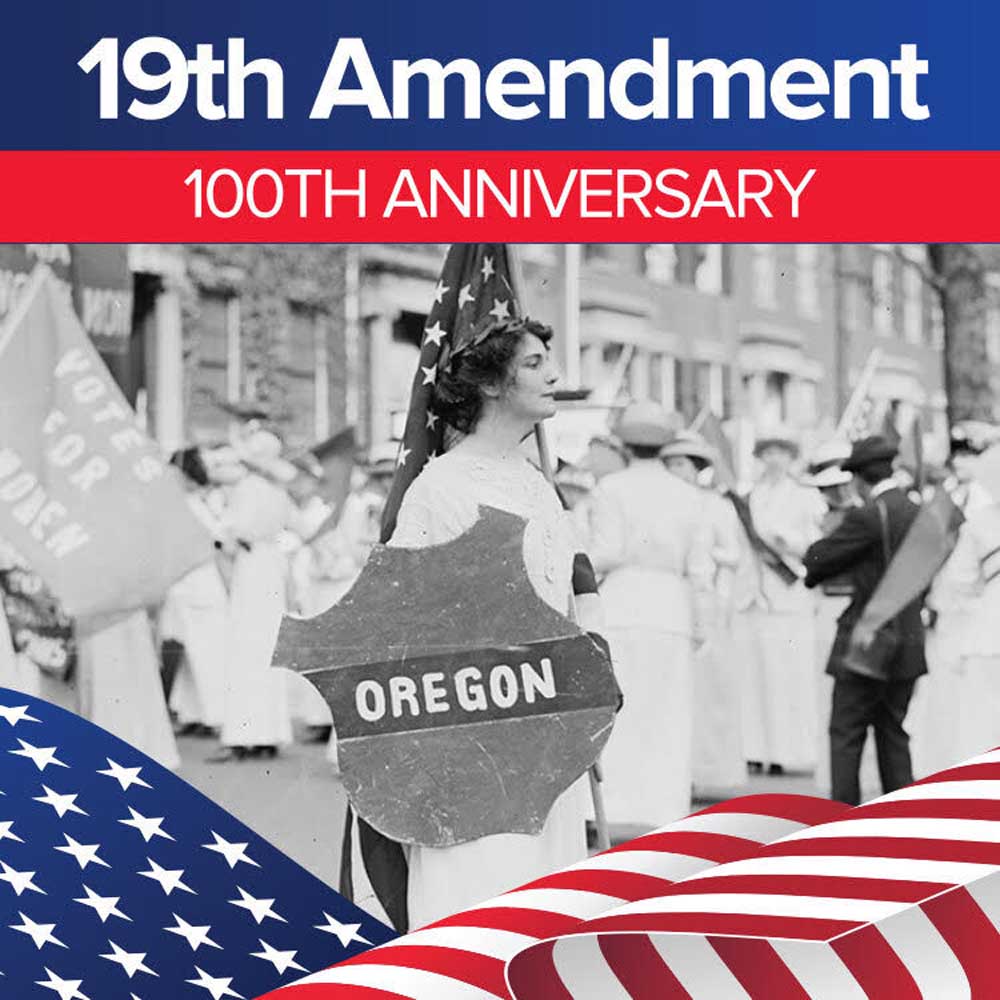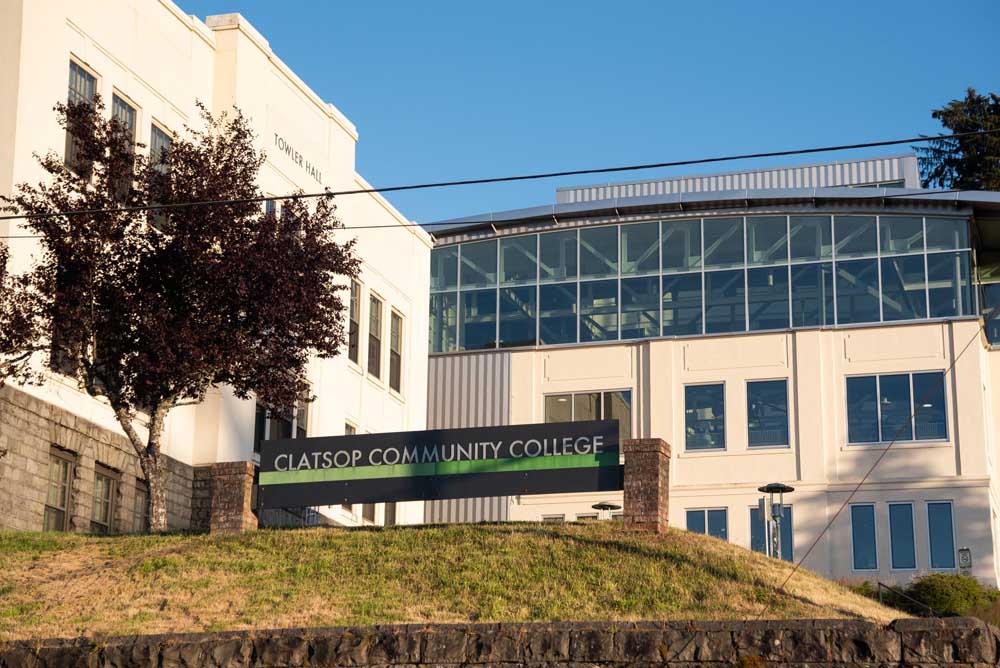Guest Column: The local fight for women’s suffrage
Published 12:30 am Thursday, July 30, 2020

- 19th Amendment logo
In celebration of the 100th anniversary of the ratification of the 19th Amendment to the U.S. Constitution, it is important to look at the role of Clatsop County in securing this right.
Trending
When Oregon ratified the 19th Amendment granting women suffrage — or the right to vote — on Jan. 12, 1920, Oregon women had already been voting in local and state elections for more than seven years.
The efforts of Oregon women to secure their right to vote spanned decades and would include the issue being placed on the ballot a record six times, more than any other state — in 1884, 1900, 1906, 1908, 1910, and finally with the passage of the Oregon Equal Suffrage Amendment, in November 1912.
Locally, the Clatsop County Equal Rights Association organized in May 1874. From the beginning, both men and women would take prominent roles in the organization. Early Astoria pioneer, Col. James Taylor, was appointed as the group’s first president, and proprietress of a local millinery shop, Hannah M. Morrison, was elected vice president.
Trending
Early suffrage efforts in Clatsop County were further boosted by the friendship between Dewitt Clinton Ireland and Abigail Scott Duniway. Ireland was editor of the local paper, The Weekly Astorian. At the same time, Duniway was a leading Oregon suffragist whose own newspaper, the New Northwest, would become the primary voice of the suffrage movement throughout the state. Ireland began reprinting Duniway’s articles in his paper, while also providing a favorable forum for the Clatsop County Equal Rights Association.
Inez Adams Parker, along with her husband, Wilder W. Parker, was a founding member of the Clatsop County Equal Rights Association. In the early 1930s, Inez wrote about her husband’s role during the 1884 election that first put the issue of women’s suffrage before Oregon voters.
According to Inez, “When the first measure for women’s suffrage was submitted to the voters in Oregon, (Wilder) was one of the three judges of election (as they were then called), and it took them all night to count the votes. When he came home next morning to his breakfast, he casually remarked to me that there were quite a few votes for woman suffrage and about the same against it, but the majority did not vote on it at all, so I said to the other two judges, ‘Those who failed to vote on it surely could not have been against it, or they would have said so; suppose then that we count all of them for it?’ ‘All right,’ they said and the result was that Clatsop was the only county that gave a majority for it … the funny thing was the way this county plumed itself afterward on being the most advanced and progressive county in the state — on the strength of that vote.”
Whether or not this occurred is unclear. The Daily Astorian’s unofficial results published the day after the election had the measure defeated in the county, with 336 people voting for women’s suffrage and 362 voting against it. The same paper reported less than three weeks later that, “Clatsop is the only county that gave (the vote on women’s suffrage) a majority.”
‘No fear’
Parker’s close friend, Dr. Bethenia Owens-Adair, played a prominent role on both the local and state level in the struggle for women’s suffrage.
In 1896, Scott Duniway, in her capacity as president of the Oregon State Equal Suffrage Association, wrote to Dr. Owens-Adair requesting Owens-Adair’s participation in the First Oregon Congress of Women, which would feature the national suffrage leader Susan B. Anthony.
Owens-Adair had met Anthony previously when, as a single mother and successful businesswomen, Owens-Adair had been asked to arrange part of Anthony’s 1871 speaking tour. This encounter helped embolden Owens-Adair to pursue her interest in medicine, becoming one of the first women in the Pacific Northwest to earn a medical degree.
Speaking before the First Oregon Congress of Women, Owens-Adair asked those in attendance, “Is there any difference between women’s work and men’s work? Is there anything under the sun that muscle or mind can do that the new woman cannot accomplish? We have no fear that the ‘new woman’ will not find a place in the poet’s theme, as well as in his heart.
“She will not cease to be the ‘ministering angel,’ the very inspiration of life. Like the fine gold that comes from the furnace, she will come forth, clothed in all the beauty and strength of pure womanhood, for she will have been cleansed of the dross of dependence, helplessness and prejudice of past ages. Indeed, up to the present time, what has man done that woman could not do or has not done?”
Often those who supported women’s suffrage were also in favor of temperance, or the prohibition of alcohol, creating a common perception that if women received the right to vote, they would use this power to outlaw alcohol consumption.
Depending upon one’s ideas about alcohol consumption, then, women’s suffrage was either a good or bad idea.
In Astoria, in the late 19th century, an estimated 1,000 regular drinkers frequented the local saloons, consuming 22,000 gallons of beer per month. In a town that clearly profited from the sale and consumption of alcohol, many opposed women’s suffrage for this very reason. Yet this connection between temperance and suffrage was not always so strong.
Scott Duniway — the leading suffragist in Oregon — for example, refused to connect the two movements for fear of alienating supporters. At the same time, Dr. Clarence True Wilson — an important member of the temperance movement — opposed granting women suffrage, as it would extend the vote to, “the wives, daughters and sweethearts of gamblers, saloonkeepers and the owners of property used for immoral purposes.”
A Flavel protests
Many women, themselves, were not interested in securing the right to vote, with some actively fighting against it.
The Oregon State Association Opposed to the Extension of the Suffrage to Women issued a statement of protest each time the question of women’s suffrage came up for a vote.
Among those signing the protest letter was a “Mrs. George T. Flavel, Astoria.” This is most likely a reference to Winona Flavel, wife of George Conrad Flavel, as her legal name at the time would have been Mrs. George C. Flavel. Winona’s mother-in-law, Mary Christina Flavel, would also have gone by Mrs. George Flavel (no middle initial). A widow at the time of the letter’s publication, however, she was more commonly referred to as Mrs. Mary C. Flavel or Mrs. M. C. Flavel.
The Women’s Suffrage Society of Astoria formed in June 1905 for the purpose of collecting signatures to get the issue of equal suffrage again on the Oregon ballot. Of the 8,000 signatures of registered voters required statewide, the Astoria group was assigned 300. This effort was successful, as the question of women’s right to vote was again put before Oregon voters in 1906. They would remain an active organization through the eventual passage of the Oregon equal suffrage bill in 1912.
Throughout the long battle for voting equality, notable suffragists included Clatsop County as part of their broader national tours, including Clara Bewick Colby, publisher of the nationally distributed newspaper the Women’s Tribune, and Emma Smith DeVoe, who spearheaded the successful 1910 campaign to win the right to vote in Washington state. Both Colby and DeVoe visited the area in 1906 ahead of that year’s statewide vote on women’s suffrage.
Another prominent suffragist, Maria Raunio, would make Astoria her home.
Raunio advocated for women’s rights in her native Finland, including the right to vote, access to educational opportunities and universal health care. Finland granted women suffrage in 1906, becoming the third country to do so after New Zealand (1893) and Australia (1902), and the first to allow women to hold national public office.
In 1907, Raunio was elected as a representative to the Finnish Parliament as a member of the leftist Social Democratic Party. Raunio, along with 18 other women, became part of the earliest, democratically-elected national governing body that allowed women full membership. Upon immigrating to Astoria in 1911, Raunio continued her political activities, becoming the first editor for the Toveritar (The Woman Comrade) — a nationally-distributed, Finnish-language newspaper focused on socialism.
The Equal Suffrage Amendment, which removed the word “male” from the voting privileges outlined in the Oregon Constitution, finally passed on Nov. 5, 1912, after receiving 52% of the male vote.
While this amendment extended the vote to the majority of Oregon women, it did not guarantee the right to vote for all Oregon women. People excluded from the full rights of citizenship based upon their race or country of origin were not allowed to vote. This included women who had migrated from Asia and Native American women, except those who were married to white men.
A first in Warrenton
On Dec. 18, 1912, voters in Warrenton chose Clara “Callie” Munson as their new mayor over her male rival by a margin of 16 votes, making Munson the first woman to hold elected office in Oregon following the passage of the Equal Suffrage Amendment the previous month.
The state newspaper noted that her election, “establishes a precedent for equal suffrage states, as it is but a little more than a month that women have had the ballot in Oregon.”
Of the 65 people who voted in this election, approximately one-third were women, though, importantly, not all of the women who voted did so for Munson. Some women actually voted against her because of her gender, believing it improper for women to hold elected office. This was Warrenton’s second special election since the passage of the equal suffrage law. During the first special election, Munson’s 71-year-old mother, Sophia Munson, became the first woman to vote legally in Clatsop County and one of the first women to vote in the state.
In 1982, Astoria elected Edith Henningsgaard (later Henningsgaard-Miller) as the city’s first female mayor.
Much of Henningsgaard’s appeal, and actual efforts, centered on her interest in revitalizing Astoria’s historic districts and courting tourism as a new monetary source for the town. This involved creating a plan to reimagine the use of Astoria’s riverfront properties, eventually creating the riverwalk district, and beginning efforts to restore the then-60-year-old Astoria Column, with Henningsgaard serving as a founding member of the Friends of the Astoria Column.
Henningsgaard’s successes would aid other women in their ventures into local politics, culminating in the first-ever female majority on Astoria’s City Council in 2014 with the election of longtime city councilor Arline LaMear as the city’s second female mayor, alongside councilors Zetty Nemlowill and Cindy Price.
In 1986, Janet Stevenson became the last mayor of Hammond before the small town at the mouth of the Columbia River was absorbed into nearby Warrenton in 1991. Stevenson had a significant political and literary career before taking on mayoral duties.
In Clatsop County, she served as a founding member of the North Coast Women’s Political Caucus — the local chapter of the National Women’s Political Caucus that was formed by such iconic women as Gloria Steinem, Shirley Chisholm and Bella Abzug. Stevens was also a noted playwright and novelist. Her last novel, “The Slope,” offered a fictionalized accounting of Owens-Adair’s time living and practicing medicine in Clatsop Plains.
On the state level, local businesswoman Mary Strong Kinney became, in 1920, one of the first women elected to serve in the Oregon State Legislature. Her prior political experience included serving as the president of the Women’s Suffrage Society of Astoria during the lead-up to the 1912 passage of the Equal Suffrage Amendment.
Kinney proved so successful as a legislator that voters in Clatsop County elected her to represent them in the state Senate in 1922, where she served during the 1923 and 1925 sessions. After Kinney, it would be 65 years before area residents selected another woman to represent them on the state level.
In 1990, voters sent Jackie Taylor — an Astoria resident and member of the Citizen Potawatomi Nation — to Salem, where she would spend a decade serving as a state representative.
Since Taylor’s election, Clatsop County voters have overwhelmingly voted for female candidates, including Joan Dukes and Betsy Johnson to the state Senate and Elaine Hopson, Deborah Boone and Tiffiny Mitchell to the state House.








